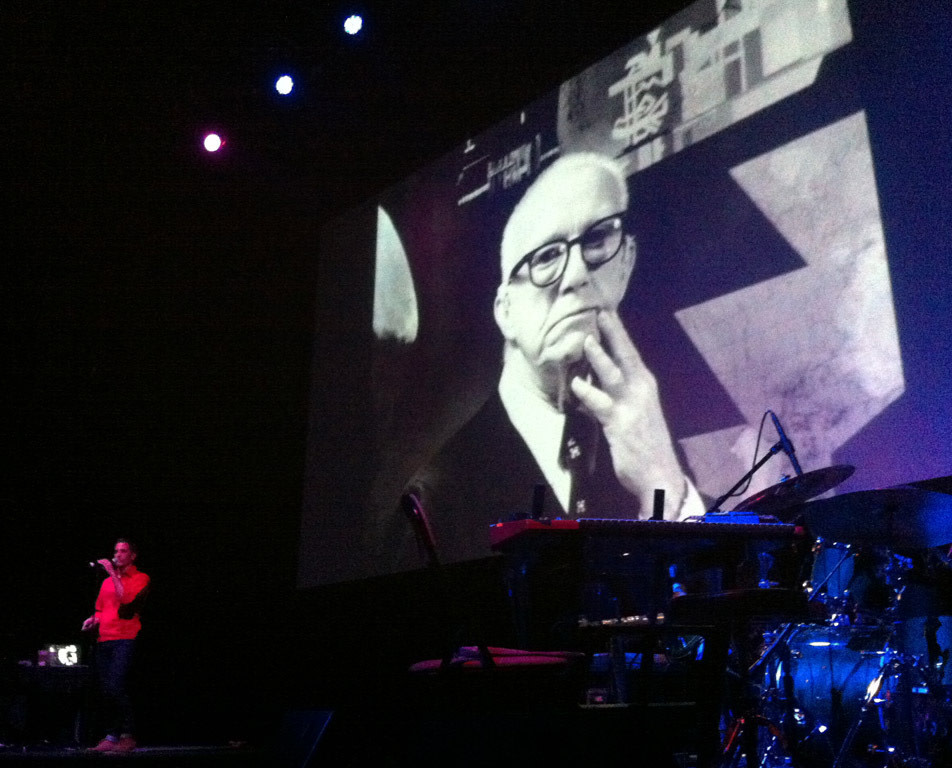TBA: Yo La Tengo/Buckminster Fuller Review

Film maker Sam Green narrates his "live documentary" about R. Buckminster Fuller at TBA. Yo La Tengo created the music, with the instruments on the right.
It was a soft summer night last week, and the 10-day TBA fest was about halfway through. The beer garden was bustling, white lights twinkling in the trees at Washington High School, ice cubes clinking in the smoky margaritas people were drinking. But inside the dark high school auditorium, the atmosphere was even sweeter. Sam Green and Yo La Tengo were performing “The Love Song of R. Buckminster Fuller.”
The piece is film maker Green’s new “live documentary,” commissioned by the San Francisco Museum of Modern Art as part of its recent exhibit on design visionary Buckminster Fuller. Green stood to the side on the big stage, laptop behind him, dwarfed by a giant screen showing archival images of Fuller and his utopian mid-20th century creations. Across the stage, the indie trio Yo La Tengo huddled, nearly hidden amidst the organized clutter of drums, synthesizers, electric and acoustic guitars. The show was on.
The TBA festival was the fifth public performance of this introduction and homage to Fuller, and it was a smooth, pleasant ride. Fuller’s life may not have been so smooth, but the edges were eased out in Green’s amiable telling of the story of a man whose utopian ideas were radical and timely then as they are now.
The visuals for the performance were the film clips and photos on the giant screen. Green had full access to Stanford Library’s collection of Fuller’s papers, and Fuller saved everything – sketches, notes, lists, films, videotapes, all in chronological order. It was an obsessively self-curated, self-created Facebook timeline, before digital devices made it easy and even mundane to document everything one does.
Green, having everything to choose from, chooses well. The big, bold, black and white and mid-century saturated color film and still images are inherently compelling and nostalgic. Many of the visuals feature Fuller himself. From our 21st century perspective, he looks like the prototypical company man – a square, not a radical. He is plain and tidy, his balding head fringed with crewcut white hair. He wears bulky horn rimmed glasses and, almost always, a white shirt, dark suit and tie. Fuller deliberately created this stark personal image, visual branding himself in a way that seems to foreshadow Steve Jobs’ black turtleneck and blue jeans or Mark Zuckerberg’s t-shirt, jeans and hoodie.
Green lets the earnestness Fuller presents evoke an atmosphere of nostalgia for today’s audience. The optimistic belief in the future is a theme of the show and of the designer’s work. Fuller believed that the world had enough resources for everyone, if only those resources were distributed equitably. (Fuller was influential, but obviously not on the Mitt Romney’s of the world.) Fuller invented (and built) an 11-person car that got 30 m.p.g.; he drew up a plan for a dome that would cover all of New York City, protecting it from the elements; and of course, he designed and built countless geodesic domes, which for him had infinite applications.
In highlighting Fuller’s life and inventions, Green frequently pauses his congenial narration and lets the original films and stills tell the story, with Yo La Tengo’s music providing beautiful and sometimes dramatic sounds. Georgia Hubley, Ira Kaplan and James McNew switch off between guitars, synthesizers, and drums to create music that wanders and builds with the images, sometimes soft and meandering, other times strong and stormy. One almost forgets the music, in the best possible way.
Yo La Tengo has created movie soundtracks before (Junebug, Shortbus, Adventureland – with Kristen Stewart, pre-Twilight – and local production Old Joy). The original music they scored to accompany the underwater sea creatures films of Jean Painleve they even played live at several performances in 2001. One of these was in Portland; the one in San Francisco Sam Green happened – fortunately – to see.
When commissioned by the SFMoMA to do the Fuller film, Green naturally turned to Yo La Tengo for the music. They worked long distance to put together the score, sending back and forth images and sounds. Final touches and rehearsals came in the last couple weeks, Green joining the band in their Hoboken studio.
The result is a live yet scripted performance, looser than a play would be, more rigid than a rock show, not repeatable the way a recorded film would be. The method raises the question of why mount such a labor-intensive hybrid. The performance would translate easily into a “normal” documentary film, but Green says he has no intentions of doing so. Perhaps he’ll change his mind with time. If anything, a “concert” film with static camera seems begging to be made. (Perhaps someone in the audience already did this that night at TBA.)
Yo La Tengo shows on their own tend to have a freer pace and can build to a frenzy. As an admitted fan of such shows, I kept wishing the band could break into their fuller sound, but the dips and peaks in the music were enough to satisfy the indie rock fan for now. And they’ll be back to Portland later this fall or winter, to promote the new album they just wrapped up. The soundtrack was a good warm-up. And for the band, it’s a nice respite from the full-on rock show. As James McNew put it, he loves these gigs – he gets to sit down.
